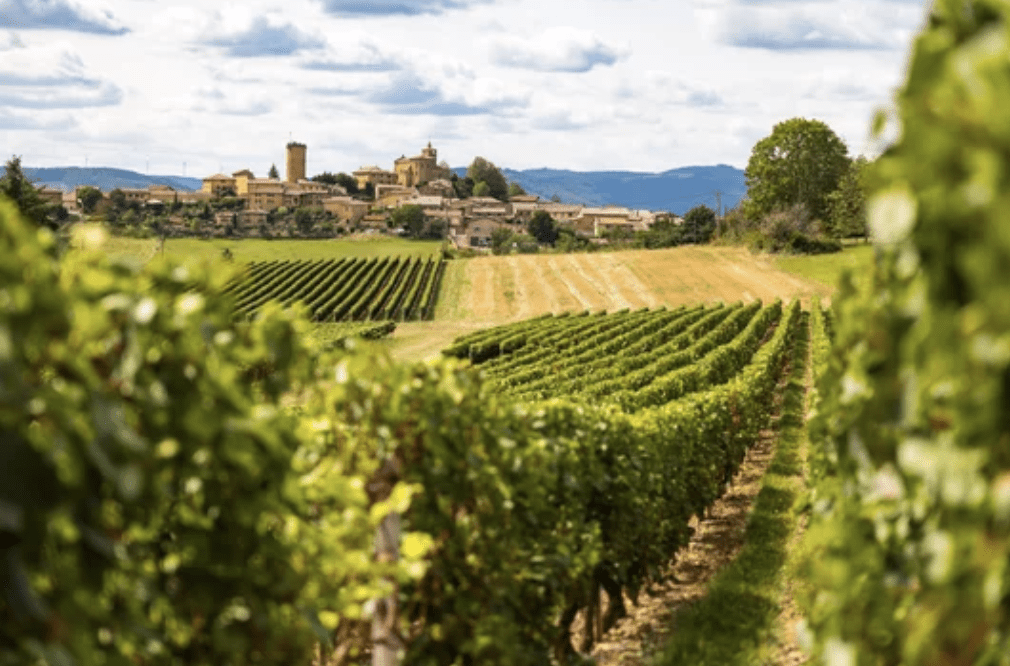
Located in the eastern part of France. The region is nestled between Burgundy to the north and Lyon to the south. The area is well known for producing light, fruity, and vibrant red wines and is part of the larger Burgundy wine region.
Geography and Climate:
- Situated along the Saône River, a tributary to the Rhone.
- Diverse terroir with varying soil types, including granite and clay.
- Semi-continental climate with warm summers and cool winters.
- The hilly landscape is ideal for vine cultivation, with slopes that maximize sun exposure.
Grape Varieties:
- Dominated by the Gamay grape variety.
- Gamay Noir à Jus Blanc is the primary clone used.
- Small plantings of Chardonnay and Pinot Noir also exist.
- Gamay thrives in Beaujolais’ soil and climate, yielding expressive wines.
Wine Styles:
1. Beaujolais Nouveau:
• This style is the most famous and distinctive, known for its youthful exuberance.
• Released on the third Thursday of November, it’s a race against time to deliver the freshest wine possible. Expect delicate red berry notes, lively acidity, and a refreshing finish.
These Wines are perfect for casual sipping or pairing with lighter dishes like grilled chicken, seafood, or pizza.
3. Beaujolais-Villages:
• A step up from the basic Beaujolais, this category offers slightly more complexity.
• Sourced from designated villages in the region, it often exhibits improved structure and depth.
• Tasting Notes: Beaujolais-Villages wines maintain the red fruit character but with added layers of flavor and a touch more body. They pair well with a broader range of foods, including roast pork, veal,and vegetarian cuisine.
4. Cru Beaujolais:
• The pinnacle of Beaujolais quality, Cru Beaujolais wines hail from ten distinct appellations, each with its unique terroir.
• These wines showcase the true potential of the Gamay grape and can age gracefully.
• Tasting Notes: The flavor profiles of Cru Beaujolais can vary significantly. Some, like Moulin-à-Vent, offer robust and age-worthy wines often compared to Burgundian Pinot Noirs. Fleurie is known for its elegance and floral notes, while Morgon delivers rich, concentrated flavors. Juliénas, on the other hand, provides structured and powerful wines. Each Cru has its own character, from the light and fragrant Chiroubles to the rustic charm of Chénas.
Production Process:
Beaujolais Nouveau’s distinct fruity and highly drinkable character is attributed to a specialized winemaking process known as carbonic maceration.
Instead of destemming Gamay grapes upon arrival at the winery, the grapes remain in whole bunches and not crushed or pressed. These bunches are then placed in sealed fermentation tanks and infused with carbon dioxide gas. This gas triggers intracellular fermentation within each grape, without the need for crushing, unlike conventional fermentation methods.
Once the grape juice reaches approximately two degrees of alcohol, the grapes burst, initiating a regular alcoholic fermentation led by the natural yeast on the grape skins to reach the final alcohol content.
Carbonic maceration has the added benefit of reducing tannin levels in the wine. Gamay, which inherently possesses low tannin content, yields Beaujolais Nouveau wines with exceptionally low tannins.
Additionally, a more traditional variation known as semi-carbonic maceration naturally occurs when whole bunches of grapes are placed in fermenters. Although this technique doesn’t produce as many fruity aromas full carbonic maceration, it retains more structural tannins. Semi-carbonic maceration is often employed in the production of higher quality cru Beaujolais wines.
Aging
The Crus may age up to 5-7 years, but err on drinking it young.
Tasting Notes:
• Beaujolais Nouveau: Bursting with red fruit flavors, such as cherry and raspberry, with a hint of banana.
• Beaujolais: Delicate red berry notes, light body, and refreshing acidity.
• Beaujolais-Villages: Slightly more depth, with added complexity and structure.
• Cru Beaujolais: Unique terroir-driven wines with nuances ranging from floral and mineral to spicy and earthy.
Food Pairing:
• Beaujolais Nouveau: Pairs well with charcuterie, roasted chicken, and light salads.
• Beaujolais: A versatile choice for grilled seafood, pizza, and pasta dishes.
• Beaujolais-Villages: Complements roasted pork, veal, and vegetarian cuisine.
• Cru Beaujolais: Matches beautifully with game, strong cheeses, and hearty stews.
Festivals and Traditions:
• Beaujolais Nouveau celebrations on the third Thursday of November, marked with parties and tastings worldwide.
• Annual Beaujolais wine auctions showcasing the region’s top offerings.
• Traditional grape harvest festivities in September, including grape stomping and local rituals.
Notable Beaujolais Crus:
1.Moulin-à-Vent:
- Known for its robust and age-worthy wines, often compared to Burgundian PinotNoirs.
2.Fleurie:
- Produces elegant and floral wines with a silky texture.
3.Morgon:
- Offers rich, concentrated wines with ripe red fruit flavors.
4.Juliénas:
- Known for its structured and powerful wines with layers of complexity.
5.Chiroubles:
- Produces light and fragrant wines, perfect for early consumption.
6.Saint-Amour:
- Known for its romantic name and wines with cherry and spice notes.
7.Brouilly:
- The largest Cru, delivering accessible, fruit-forward wines.
8.Côte de Brouilly:
- Grown on the slopes of Mont Brouilly, it offers a distinct mineral character.
9.Régnié:
- A newer Cru, known for soft and approachable wines.
10.Chénas:
- Known for its rustic charm and vibrant cherry flavors.
Conclusion:
Beaujolais is a captivating wine region renowned for its distinctive Gamay wines. Its diverse range of styles, from the youthful Beaujolais Nouveau to the complex Cru Beaujolais, ensures there’s a wine for every palate. The region’s rich history, unique production methods, and festive traditions make it a fascinating destination for wine enthusiasts.
For further reading about Beaujolais Wines visit: https://charlieturnbull.com/beaujolais-wines-beautiful-happy-wines/



